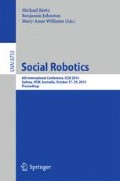Abstract
Autism Spectrum Disorders (ASD) represent one of the most prevalent developmental disorders among children with different level of impairments in social relationships, communication and imagination. In addition, impaired movement is also observed in individuals with ASD and recent studies consider this factor as a limitation for fully engagement in the social environment. In the present work, we propose a new approach to promote postural education in autistic children with the involvement of a humanoid social robot and the therapist in a triadic interaction environment to better understand their motor development and body consciousness.
Access this chapter
Tax calculation will be finalised at checkout
Purchases are for personal use only
Preview
Unable to display preview. Download preview PDF.
References
Schilling, D.L., Schwartz, I.S.: Alternative seating for young children with autism spectrum disorder: Effects on classroom behavior. Journal of Autism and Developmental Disorders 34(4), 423–432 (2004)
Srinivasan, S.M., Pescatello, L.S., Bhat, A.N.: Current Perspectives on Physical Activity and Exercise Recommendations for Children and Adolescents With Autism Spectrum Disorders. Physical Therapy (2014)
Akalin, N., Uluer, P., Kose, H., Ince, G.: Humanoid robots communication with participants using sign language: An interaction based sign language game. In: 2013 IEEE Workshop on Advanced Robotics and its Social Impacts (ARSO), November 7-9, pp. 181–186 (2013)
World Health Organization (Ed.): International Classification of Functioning, Disability, and Health: Children & Youth Version: ICFCY. World Health Organization (2007)
Robins, B., Dautenhahn, K., Te Boekhorst, R., Billard, A.: Robotic assistants in therapy and education of children with autism: can a small humanoid robot help encourage social interaction skills? Universal Access in the Information Society 4(2), 105–120 (2005)
Dautenhahn, K., Werry, I.: Towards interactive robots in autism therapy: Background, motivation and challenges. Pragmatics & Cognition 12(1), 1–35 (2004)
Ros, R., Baroni, I., Demiris, Y.: Adaptive humanrobot interaction in sensorimotor task instruction: From human to robot dance tutors. Robotics and Autonomous Systems 62(6), 707–720 (2014)
Knott, F., Dunlop, A.W., Mackay, T.: Living with ASD How do children and their parents assess their difficulties with social interaction and understanding? Autism 10(6), 609–617 (2006)
Pioggia, G., Igliozzi, R., Sica, M.L., Ferro, M., Muratori, F., Ahluwalia, A., De Rossi, D.: Exploring emotional and imitational android-based interactions in autistic spectrum disorders. Journal of CyberTherapy & Rehabilitation 1(1), 49–61 (2008)
Boucenna, S., Narzisi, A., Tilmont, E., Muratori, F., Pioggia, G., Cohen, D., Chetouani, M.: Interactive technologies for autistic children: A review. In: Cognitive Computation. Springer (2014), http://www.isir.upmc.fr/files/2014ACLI3112.pdf
Cabibihan, J.J., Javed, H., Ang Jr, M., Aljunied, S.M.: Why robots? A survey on the roles and benefits of social robots in the therapy of children with autism. International Journal of Social Robotics 5(4), 593–618 (2013)
Aldebaran–Robotics company, http://www.aldebaran-robotics.com
Ferrari, E., Robins, B., Dautenhahn, K.: Therapeutic and educational objectives in robot assisted play for children with autism. In: 18th IEEE International Symposium on Robot and Human Interactive Communication, RO-MAN 2009, pp. 108–114 (September 2009)
Tilstone, C., Layton, L.: Child development and teaching pupils with special educational needs. Routledge Falmer (2004)
Ricks, D.J., Colton, M.B.: Trends and considerations in robot-assisted autism therapy. In: 2010 IEEE International Conference on Robotics and Automation (ICRA), pp. 4354–4359 (2010)
Tarbox, J., Dixon, D.R., Sturmey, P., Matson, J.L.: Handbook of Early Intervention for Autism Spectrum Disorders: Research, Policy, and Practice. Springer (2014)
Smith, V., Sung, A.: Computer Interventions for ASD. In: Comprehensive Guide to Autism, pp. 2173–2189. Springer, New York (2014)
Author information
Authors and Affiliations
Editor information
Editors and Affiliations
Rights and permissions
Copyright information
© 2014 Springer International Publishing Switzerland
About this paper
Cite this paper
Palestra, G. et al. (2014). Social Robots in Postural Education: A New Approach to Address Body Consciousness in ASD Children. In: Beetz, M., Johnston, B., Williams, MA. (eds) Social Robotics. ICSR 2014. Lecture Notes in Computer Science(), vol 8755. Springer, Cham. https://doi.org/10.1007/978-3-319-11973-1_30
Download citation
DOI: https://doi.org/10.1007/978-3-319-11973-1_30
Publisher Name: Springer, Cham
Print ISBN: 978-3-319-11972-4
Online ISBN: 978-3-319-11973-1
eBook Packages: Computer ScienceComputer Science (R0)

